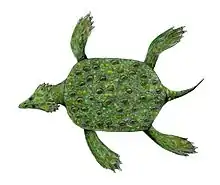Fluvionectes
Fluvionectes (meaning "river swimmer", from both Latin and Greek) is a genus of elasmosaurid plesiosaur found in the Dinosaur Park Formation in Alberta, Canada. It is known from a holotype, which includes parts of the trunk area, and from a much larger specimen referred to this taxon.[1]
| Fluvionectes Temporal range: Campanian ~ | |
|---|---|
| Life restoration | |
| Scientific classification | |
| Domain: | Eukaryota |
| Kingdom: | Animalia |
| Phylum: | Chordata |
| Class: | Reptilia |
| Superorder: | †Sauropterygia |
| Order: | †Plesiosauria |
| Family: | †Elasmosauridae |
| Genus: | †Fluvionectes Campbell et al., 2021 |
| Species: | †F. sloanae |
| Binomial name | |
| †Fluvionectes sloanae Campbell et al., 2021 | |
Description
The holotype of Fluvionectes reached 5 m (16 ft) long and weighed 500 kg (1,100 lb). A much larger specimen indicates that this taxon may have reached 7 m (23 ft) in maximum body length.[1][2]
Classification
The describers placed Fluvionectes in the Elasmosauridae, in a clade with Albertonectes, Nakonanectes, Styxosaurus, and Terminonatator, which by definition places it in the Elasmosaurinae subfamily.[1]
Paleobiology
Fluvionectes appears to have been a freshwater (and possibly brackish water) animal based on its discovery from a non-marine to paralic sedimentary unit. This is significantly different in contrast to most elasmosaurs which were oceanic.[1]
References
- Campbell, Mitchel, Ryan and Anderson, James A., Mark T., Michael J., Jason S. (2021). "A new elasmosaurid (Sauropterygia: Plesiosauria) from the non-marine to paralic Dinosaur Park Formation of southern Alberta, Canada". PeerJ. 9: e10720. doi:10.7717/peerj.10720. PMC 7882142. PMID 33614274.
{{cite journal}}: CS1 maint: multiple names: authors list (link) - Paul, Gregory S. (2022). The Princeton Field Guide to Mesozoic Sea Reptiles. Princeton University Press. p. 114. ISBN 9780691193809.






.png.webp)